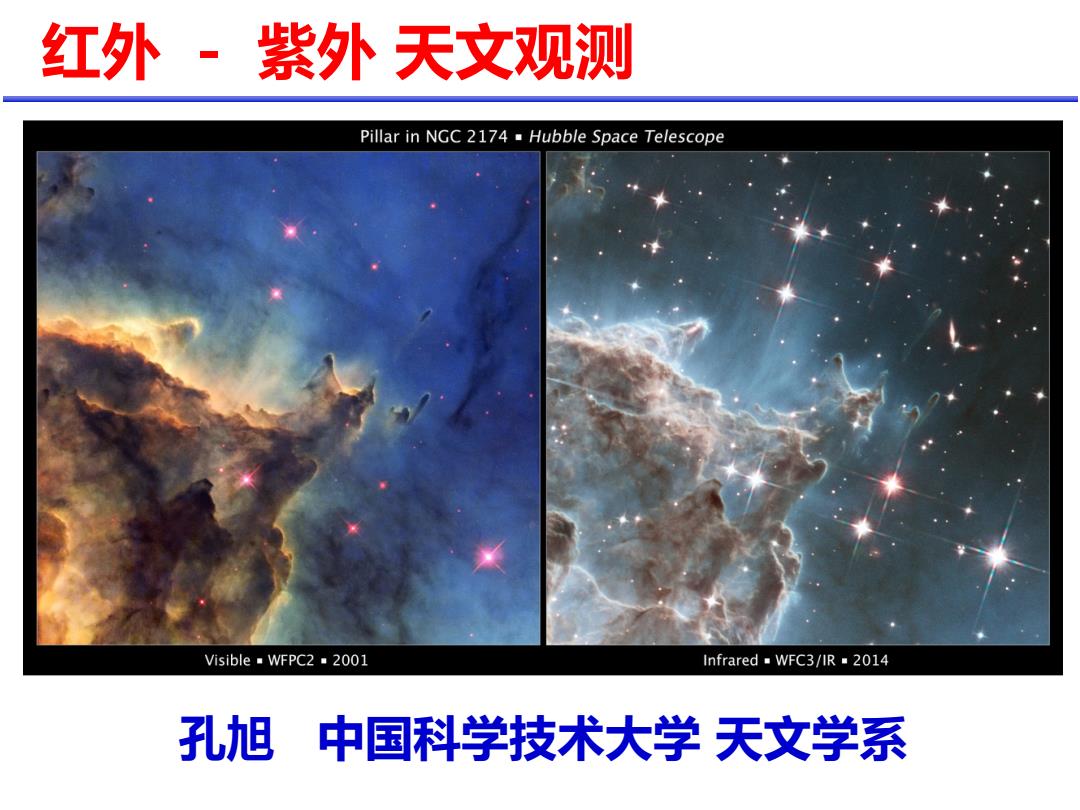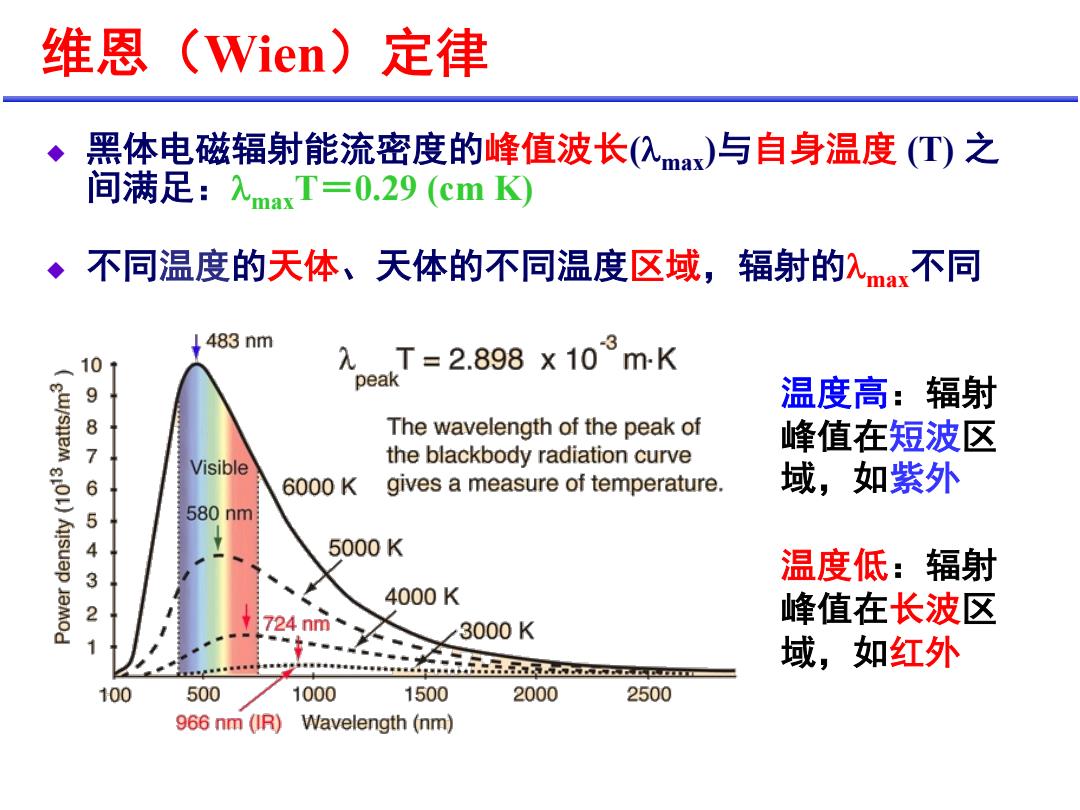
红外·紫外天文观测 Pillar in NGC 2174 Hubble Space Telescope Visible■WFPC2■2001 Infrared■WFC3/IR■2014 孔旭 中国科学技术大学天文学系
红外 - 紫外 天文观测 孔旭 中国科学技术大学 天文学系

课程内容 Radin Infrared visible ltraviolet (1 amma () 基本知识 waves radiation light 红外天文 紫外天文 课程总结 望远镜台址 研究对象 观测终端 望远镜结构
!"#$ u !"#$ u %&'( u )&'( u *+,- . / 0 1 !"#$% ()*+ !"#&

1.基本知识 .All objects in the Universe emit light depending on their temperature:物体温度决定其辐射波长 ◆低温物体:辐射主要分布在长波区间 Human ◆高温物体:辐射主要分布在短波区间 SPECTRAL CLASS Infrared 33°C(306K) Electric Stove SURFACE TEMPERATURE 0 B AFGK M 30,000 25,000 20,000 15,000 10,000 5,000 Kelvins Red Light 4,130°C(4,400K
Infrared 33° C (306 K) Red Light 4,130° C (4,400 K) Electric Stove Human 1. %&'( u All objects in the Universe emit light depending on their temperature,-./01234567 u 23456789:;?@A u B3456789:;<=C?@A

维恩(Wien)定律 黑体电磁辐射能流密度的峰值波长(入ma)与自身温度(T)之 间满足:maxT=0.29(cmK) 不同温度的天体、天体的不同温度区域,辐射的入max不同 483nm 10 λT=2.898x10m-K peak 987 温度高:辐射 The wavelength of the peak of 峰值在短波区 Visible the blackbody radiation curve 6 6000K gives a measure of temperature. 域,如紫外 5 580nm 4 5000K 3 温度低:辐射 4000K 2 724nm 峰值在长波区 3000K 2a 域,如红外 100 500 1000 1500 2000 2500 966nm(0R) Wavelength(nm)
)*+Wien,-. u D5EF78GHIJKLM?>(lmax)NOP3J (T) Q ARS6lmaxTT0.29 (cm K) u UV3JK'5W'5KUV3J@XY78KlmaxUV 3JB678 LM=C?@ XYZ)& 3J2678 LM=>?@ XYZ%&

Visible (VLT] Infrared Combined Protostellar Jet in BHR 71 Dark Cloud Spitzer Space Telescope.IRAC NASA JPL-Caltech T.Bourke [Harvard-Smithsonian CfA) sig07-005 An object can look radically 分子云BHR71:光学波段显示为暗云, different depending on the type of 而红外波段显示暗云内,年轻的恒星 light collected from it 正在形成
!"#BHR71$%&'()*+,#- ./0'()*,#1-23456 789: An object can look radically different depending on the type of light collected from it

Vicilo M33:The Triangulum Galaxy GAGalaxy Evolution Explorer 多波段观测、研究天体重要: Domposite 2624 microns 同一天体的不同波段的辐射来 自不同(温度)的区域,和不同 物理过程相关 24 microns 8.0 mnicrono 3.6 microne ,不同观测波段,有各自的优势 Spiral Galaxy M81 Spitzer Space Telescope·MlpS·lRAC hscE Wubo lght [NO约 NfsA/JLCnoch/K.Cordon (ueicererol Ariroool S Wihoe [fareerd-Smithsonian CIA) x200208d ◆ 不同观测波段,观测仪器和方 法有各自特点→多波段天文
;'(?@ABCD$ u !"#$%&!'(%)*+ ,&!-./0%1234&! 56789: u &!;,%?@ u &!;,EF à G'(#H

Multi-wavelength Astronomy 波段 波长范围 温度 What can be studied Gamma 100keV- >108K accretion disks,gamma-ray bursts rays 100MeV X-rays 1m <10K Radiation from electrons moving in a magnetic field:pulsars Astronomers used to think of themselves as either 'optical',radio','IR'or X- ray':different physical processes can be studied at different wavelengths
Multi-wavelength Astronomy ' ( 'EFG H I What can be studied Gamma rays 100keV- 100MeV >108K accretion disks, gamma-ray bursts X-rays 1m <10K Radiation from electrons moving in a magnetic field: pulsars Astronomers used to think of themselves as either ‘optical’, ‘radio’, ‘IR’ or ‘XJ ray’$different physical processes can be studied at different wavelengths

2.红外天文 红外天文学:利用红外波段,研究天体的学科 2.1红外窗口 What Do We See In The Infrared? 2.2观测意义 stars 2.3观测特点 ust and gas near stars 2.4望远镜 interstellar matter 10,000°K Energy 1.000°K 100K 热图 Ultra- Visible Near Far violet Infrared Infrared
2. /012 !"#$%&'(!")*+,-#./%0 2.1 89:; 2.2 ()? 2.4 ! " # 热图

Example Galaxy SEDs 109 ULIRG (CFRS 14.1139)x 106 10-10 1011 Starburst(M 82 (2-WM)"In 1012 Disk (M 101) 10-13 1014 Elliptical (NGC 5018) 1015 0.1 10 100 1000 Wavelength (um) Significant IR emission from both AGN and star formation
Example Galaxy SEDs Significant IR emission from both AGN and star formation

Discovery of the Infrared 1800年,英国天文学家威 廉·赫歇尔在研究太阳的热辐 glass 射时,偶然发现了“红外线” white light prism ◆发现一个奇怪的现象:放在光带 红光之外的一支温度计,比室内 其他温度计的指示数值高 ◆波长比“光学波段红光”长的电 磁波,具有明显热效应,人能感 in shadow 觉到而看不见 to measure ambient temperature increasing wavelength- gamma X-rays ultra- violet microwaves radar radio waves rays light 红外波长区间? 0co28 feel warmth- illuminated with 0.7 1.000 single color micrometers
Discovery of the Infrared u 18002-KLAM&NO P·QRS8?@TU4VW XY-Z[\]^_/0`a u !"#$%&'"()*+,- .,/0'#12345678 9:234';? u 'IJKLM'(NLOI%P Q'3R=STUVW3XYZ [\]^&_ N`'I1ab